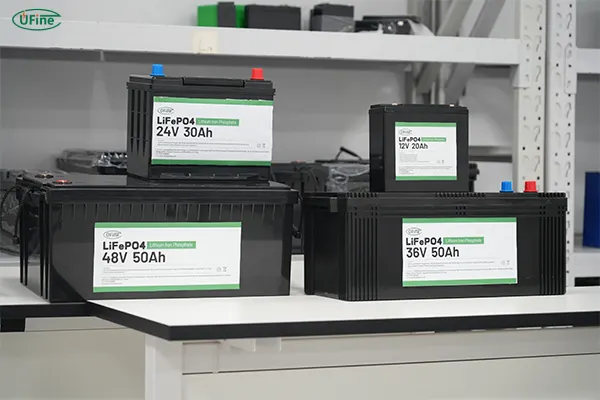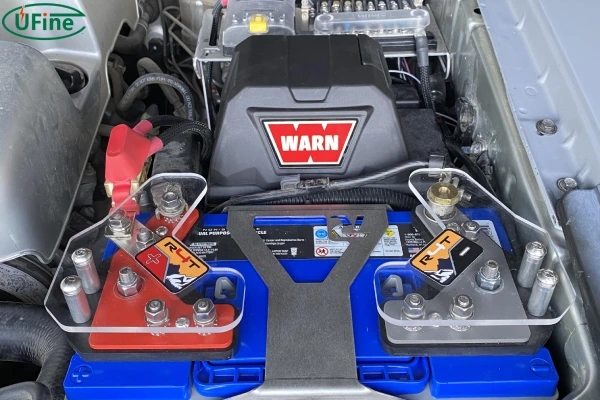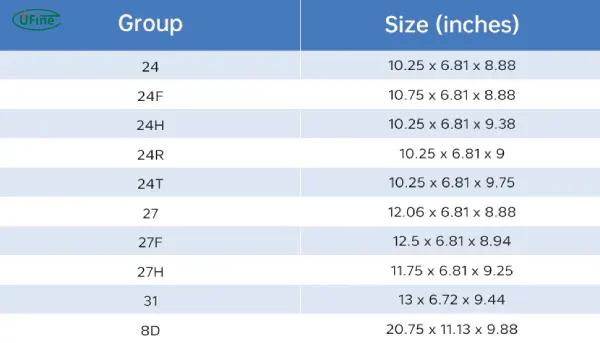Part 1. What are Group 31 batteries?
The “Group 31” designation for a battery, like other group sizes, is defined by the Battery Council International (BCI). This standardization helps ensure compatibility across different applications by specifying the dimensions and characteristics of the batteries in each group.
1. Standardization:
The BCI establishes group sizes to standardize the dimensions and specifications of batteries used in automotive and industrial applications.
Each group size corresponds to specific measurements to ensure that the batteries will fit properly in designated compartments.
2. Physical Dimensions:
Group 31 batteries have specific dimensions: approximately 13 inches (330 mm) in length, 6.8 inches (173 mm) in width, and 9.44 inches (240 mm) in height.
These dimensions can vary slightly by manufacturer but adhere closely to the BCI standards for consistency.
Application:
The “Group 31” designation is a standardized classification that helps users and manufacturers identify batteries with specific dimensions and performance characteristics. This standardization ensures that batteries will fit properly and meet the power requirements of various heavy-duty applications. The number “31” is simply a part of the BCI’s labeling system to differentiate between the different group sizes, ensuring consistency and compatibility across different brands and models.
3. Key Features of Group 31 Batteries
- High Capacity: Group 31 batteries are designed to deliver substantial power, making them ideal for applications that require a steady and reliable energy source.
- Durability: Built to withstand harsh environments and heavy usage, these batteries are rugged and dependable.
- Versatility: Their broad range of uses spans various industries, including automotive, marine, industrial, and renewable energy sectors.
Part 2. What is the difference between Group 31 batteries and other battery groups?
Group 31 batteries are a specific size of lead-acid batteries, often used in marine, RV, and commercial applications due to their versatility, size, and capacity. They have a standard measurement of 12.0 x 6.8 x 8.9 inches and typically offer 75 to 130 amp-hours of power. What sets Group 31 batteries apart from other battery groups is their capacity to handle both deep discharge and recharging cycles efficiently, making them suitable for various high-demand uses.
When compared to smaller battery groups, like Group 24 or Group 27, Group 31 batteries offer more power and can store more energy, which is why they are preferred in applications that require extended runtime, like marine or off-grid setups. Larger groups, such as Group 4D and Group 8D batteries, offer even greater capacity but come with a larger footprint, making them less suitable for smaller or compact spaces.
Part 3. Compare 31 group battery types: Lithium, AGM, Gel and Flooded
There are several types of Group 31 batteries, each offering unique benefits and suited to different needs. Understanding these types can help you choose the right battery for your specific application.
1. Group 31 Flooded Lead-Acid Batteries
These traditional batteries contain liquid electrolytes that dissolve the battery plates.
They require regular maintenance, such as checking electrolyte levels and adding distilled water. Despite this, they are cost-effective and provide reliable power, making them popular for many applications.
2. Group 31 AGM (Absorbent Glass Mat) Batteries
AGM batteries use a fiberglass mat to absorb the electrolyte, making them spill-proof and maintenance-free.
With a lower self-discharge rate and the ability to handle higher discharge rates, AGM batteries are more efficient and perform better than flooded batteries. They are more expensive but offer superior reliability and convenience.
3. Group 31 Gel Batteries
These batteries use a gelled electrolyte, making them spill-proof and maintenance-free.
Gel batteries are robust against vibrations and shocks, have a longer lifespan than flooded batteries, and are ideal for applications where durability and longevity are crucial. They are, however, more costly.
4. Group 31 Lithium-Ion Batteries
Lithium-ion batteries are modern, high-performance batteries using lithium compounds to store energy.
They are lightweight, have a high energy density, and have a significantly longer lifespan compared to other types. Although they are the most expensive option, their efficiency and performance make them a top choice for cutting-edge applications.
Part 4. What is the best Group 31 Battery?
Through the above analysis of various types of Group 31 Battery, the “best” Group 31 battery depends on your specific needs:
- Lithium is the best for long-term value and efficiency if you’re willing to invest upfront.
- AGM offers a solid balance of performance, maintenance-free operation, and durability.
- Gel batteries are excellent for extreme temperatures and long cycle life but come with a higher price tag.
- Flooded batteries are the most cost-effective but require more maintenance and don’t handle deep discharges as well as the others.
Choosing the right type ultimately depends on your budget, application, and how much maintenance you’re willing to perform.
Part 5. Group 31 battery parameters
Understanding the key parameters of Group 31 batteries is essential for selecting the right battery for your needs. Here are four common parameters:
1. Size
Group 31 batteries typically measure approximately 13 x 6.8 x 9.4 inches. This standardized size makes them versatile and suitable for a wide range of applications, fitting into various battery compartments without the need for modifications.
2. Weight
The weight of Group 31 batteries can vary depending on the type. Flooded lead-acid batteries are the heaviest, weighing around 70 to 75 pounds. AGM batteries are slightly lighter, while lithium-ion batteries are the lightest, often weighing less than 60 pounds. The weight factor is important to consider, especially for applications where mobility and ease of handling are important.
3. Voltage
Most Group 31 batteries operate at a standard voltage of 12 volts. This voltage is sufficient to power a wide range of devices and systems, from automotive engines to marine electronics. Some specialized applications might require batteries with different voltages, but 12 volts is the most common and widely used.
4. Capacity
Capacity is a measure of how much energy a battery can store, typically expressed in ampere-hours (Ah). Group 31 batteries usually have capacities ranging from 75Ah to 125Ah. Higher capacity batteries can provide longer run times, which is crucial for applications that require sustained energy over extended periods.
Part 6. Ufine Battery: custom Group 31 lithium batteries for your needs
If you’re looking for a customized Group 31 battery, Ufine Battery is here to provide the perfect solution. As a leading Chinese manufacturer, we specialize in designing lithium-ion batteries, LiFePO4 batteries, and more, tailored to your exact requirements in size, shape, voltage, and capacity.
Whether you need a Group 31 lithium battery for marine, RV, or off-grid use, we offer high-performance, durable options that provide longer lifespan, faster charging, and deeper discharge cycles than traditional lead-acid batteries.
Contact Us Today. For custom Group 31 batteries or any other lithium battery needs, contact us today to discuss your specific requirements. Our expert team will help you find the best solution for your project.
Part 7. Group 31 deep cycle battery

A Group 31 deep cycle battery is specifically designed for applications that require long, steady power output, rather than short bursts of high energy. These batteries can discharge a significant portion of their capacity and still recover without damaging their internal components. They are ideal for use in RVs, marine applications, and solar systems, where consistent, prolonged power is needed.
Deep cycle batteries are typically more durable and resistant to repeated discharges, making them perfect for high-demand situations. If you’re looking for reliability over an extended period, a deep cycle Group 31 is an excellent choice.
Part 8. Group 31 marine battery
A Group 31 marine battery is a specific type of battery that is designed for marine environments, where conditions can be harsh. These batteries combine the features of deep cycle batteries with the power capabilities of starting batteries, allowing them to both start your boat’s engine and provide power to your onboard electronics for extended periods.
Marine Group 31 batteries are built to withstand constant vibration, exposure to saltwater, and fluctuating temperatures. Many marine batteries in this group are AGM (Absorbent Glass Mat) or gel batteries, which offer better performance and longer lifespan than traditional flooded lead-acid batteries.
Part 9. Group 31 battery price
The price of a Group 31 battery can vary depending on the type (flooded, AGM, or gel), brand, and capacity. On average, you can expect to pay:
- Flooded Lead-Acid Group 31 Batteries: $100 – $150
- AGM Group 31 Batteries: $150 – $250
- Gel Group 31 Batteries: $200 – $300
Part 10. How long does a Group 31 battery last?
The lifespan of a Group 31 battery depends on several factors, including the type of battery, usage patterns, maintenance, and environmental conditions. Here’s a general overview of the expected lifespan for different types of Group 31 batteries:
1. Group 31 Flooded Lead-Acid Batteries
Flooded lead-acid batteries are the most traditional type and typically last between 3 to 5 years with proper maintenance. Regular maintenance includes checking and topping off electrolyte levels and ensuring the battery is kept in a charged state to prevent sulfation.
2. Group 31 Sealed Lead-Acid (SLA) Batteries
Sealed Lead-Acid batteries, including AGM (Absorbent Glass Mat) batteries, are maintenance-free and have a slightly longer lifespan than flooded lead-acid batteries. These batteries generally last between 4 to 7 years. The longevity of SLA batteries is due to their sealed design, which prevents electrolyte evaporation and contamination.
3. Group 31 Absorbent Glass Mat (AGM) Batteries
AGM batteries are a subtype of SLA batteries with enhanced performance characteristics. They typically last between 4 to 7 years, similar to standard SLA batteries. However, they offer better deep cycle capabilities and are more resistant to vibration and temperature fluctuations.
4. Group 31 Lithium-Ion Batteries
Lithium-ion batteries are the most advanced and can last significantly longer than lead-acid types. On average, lithium-ion Group 31 batteries have a lifespan of 10 to 15 years. They can endure many more charge and discharge cycles (up to several thousand) compared to lead-acid batteries, which contributes to their extended life.
Factors Influencing Battery Lifespan
Several factors can affect the lifespan of a Group 31 battery:
- Usage Patterns: Frequent deep discharges shorten battery life. Lead-acid batteries, in particular, suffer from reduced lifespan when repeatedly discharged below 50% of their capacity.
- Maintenance: Proper maintenance, such as regular charging and electrolyte level checks (for flooded batteries), can extend the life of the battery.
- Temperature: Extreme temperatures (both hot and cold) can adversely affect battery life. Batteries generally last longer when kept in a stable, moderate climate.
- Charging Practices: Using an appropriate charger and avoiding overcharging or undercharging can significantly prolong battery life. Smart chargers that adjust the charging rate and prevent overcharging are beneficial.
- Storage Conditions: When not in use, batteries should be stored in a cool, dry place and kept at an optimal charge level to prevent degradatio.
Related Tags:
More Articles

Easy Guide: Picking the Right Garden Tractor Battery.
Confused about your garden tractor battery? Find the right battery & keep your lawn tractor running strong! Read more here.
Learn Deep Cycle Battery Charging
Confused about charging deep cycle batteries? Don't be! Our guide breaks down the process. You'll learn the best ways to charge your battery safely.
Battery Array vs. Single Battery: Which Is Right for Your Energy Needs?
Battery array vs. single battery: Learn how they work, their benefits, and which option best suits your energy needs for performance and cost.
What Is a Battery Array?
A battery array is a group of connected batteries ensuring reliable power. This article covers its types, benefits, and key applications.
Growth Trends in the Flexible Thin Film and Printed Battery Market
The flexible thin film and printed battery market is evolving fast. This article covers its growth, innovations, challenges, and future trends.





